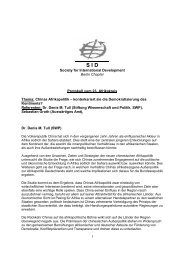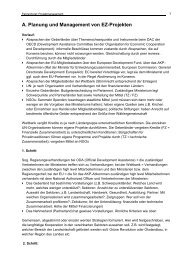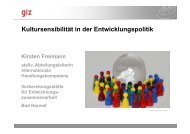Konferenzbericht (PDF-Dokument, 3 MB) - SID
Konferenzbericht (PDF-Dokument, 3 MB) - SID
Konferenzbericht (PDF-Dokument, 3 MB) - SID
Erfolgreiche ePaper selbst erstellen
Machen Sie aus Ihren PDF Publikationen ein blätterbares Flipbook mit unserer einzigartigen Google optimierten e-Paper Software.
Wissen wandert<br />
besser verstehen und darauf reagieren. Europa muss<br />
ebenso seinen eigenen Gesellschaften erklären, welche<br />
demographischen und wirtschaftlichen Bedürfnisse es in<br />
Bezug auf Migration hat.<br />
In trying to decipher African perspectives on European<br />
migratory policy, it is necessary to first and foremost put<br />
into perspective what these policies are and what their<br />
overall intention is.<br />
Broadly speaking, the last few years has seen Europe<br />
come up with a flurry of initiatives whose ostensible aim<br />
was to reduce the flow of illegal immigrants who show<br />
up on the southern coasts of Europe. The spring to<br />
autumn season has no shortage of dramatic images of<br />
young African men, women and children being lifted out<br />
of the seas in terrible conditions after incredible, harrow-<br />
ing journeys across land and sea. Those are the lucky<br />
ones who make it to the other side – often barely alive,<br />
but nonetheless alive. A good number of prospective<br />
migrants never make it alive.<br />
Arthur Muliro<br />
What are the driving forces that propel Africa‟s future –<br />
its young women and men – to risk all to try and reach<br />
their new El Dorado, Europe? This list does not pretend<br />
to be exhaustive – I merely list the more prominent ones:<br />
- Stagnating economic performance – even though<br />
African economies have been recording some im-<br />
pressive growth figures, this growth has failed to<br />
trickle down to the majority of the young and un-<br />
employed; the poor. Add to this the inability of the<br />
knowledge migrates<br />
majority to make a decent living off the land (either<br />
through low prices for crops or due to environmental<br />
challenges). Thus, they have been forced by exi-<br />
gency to seek their fortunes elsewhere.<br />
- Conflict – endemic conflict has displaced thou-sands<br />
of people who have been forced to leave their homes<br />
and livelihoods in their search for safety.<br />
- Demographics and labour demand – particularly in<br />
Europe. There is a strong need for cheap (and un-<br />
documented) labour. The reality is that European<br />
economies depend on these illegal immigrants,<br />
much as they are denigrated and reviled. The flip<br />
side of this is that there is a surfeit of young, able-<br />
bodied people in Africa.<br />
- Improving infrastructure – as infrastructure is devel-<br />
oped and it becomes easier (relatively speaking) to<br />
travel across the continent, the barriers to travel are<br />
lowered and more people are tempted to make the-<br />
se crossings.<br />
It is also important to note that most of the international<br />
migration in Africa has occurred and still occurs outside<br />
a regulatory framework, largely due to the fact that few<br />
African countries have a well-articulated policy on inter-<br />
national migration and where these exist, few countries<br />
actually enforce their own laws and regulations on emi-<br />
gration rigidly. Furthermore, the debate on Euro-African<br />
migration generally assumes that there is a neat and<br />
clear distinction between „receiving‟ and „sending‟ coun-<br />
tries. Many African countries are not only receiving and<br />
sending countries, but also transit countries. Yet the<br />
current literature and debate neglects this reality, focus-<br />
ing much more on a simple dichotomy of „sending‟ and<br />
„receiving‟ countries in which case, Europe is the recipi-<br />
ent and Africa the sender. Yet the reality is that the ma-<br />
jorities of flows take place within Africa and remain in<br />
Africa.<br />
The current policy framework as articulated by Europe –<br />
as stated earlier – has the control of migratory flows as a<br />
35







